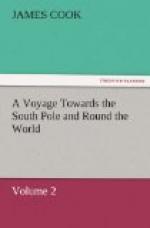Staten Land lies near E. by N. and W. by S., and is ten leagues long in that direction, and no where above three or four leagues broad. The coast is rocky, much indented, and seemed to form several bays or inlets. It shews a surface of craggy hills which spire up to a vast height, especially near the west end. Except the craggy summits of the hills, the greatest part was covered with trees and shrubs, or some sort of herbage, and there was little or no snow on it. The currents between Cape Deseada and Cape Horn set from west to east, that is, in the same direction as the coast; but they are by no means considerable. To the east of the cape their strength is much increased, and their direction is N.E. towards Staten Land. They are rapid in Strait Le Maire and along the south coast of Staten Land, and set like a torrent round Cape St John; where they take a N.W. direction, and continue to run very strong both within and without New Year’s Isles. While we lay at anchor within this island, I observed that the current was strongest during the flood; and that on the ebb its strength was so much impaired, that the ship would sometimes ride head to the wind when it was at W. and W.N.W. This is only to be understood of the place where the ship lay at anchor, for at the very time we had a strong current setting to the westward, Mr Gilbert found one of equal strength near the coast of Staten Land setting to the eastward, though probably this was an eddy current or tide.
If the tides are regulated by the moon, it is high-water by the shore at this place on the days of the new and full moon, about four o’clock. The perpendicular rise and fall is very inconsiderable, not exceeding four feet at most. In Christmas Sound it is high-water at half past two o’clock on the days of the full and change, and Mr Wales observed it to rise and fall on a perpendicular three feet six inches; but this was during the neap tides, consequently the spring tides must rise higher. To give such an account of the tides and currents on these coasts as navigators might depend on, would require a multitude of observations, and in different places, the making of which would be a work of time. I confess myself unprovided with materials for such a task; and believe that the less I say on this subject the fewer mistakes I shall make. But I think I have been able to observe, that in Strait Le Maire the southerly tide or current, be it flood or ebb, begins to act on the days of new and full moon about four o’clock, which remark may be of use to ships who pass the strait.
Were I bound round Cape Horn to the west, and not in want of wood or water, or any other thing that might make it necessary to put into port, I would not come near the land at all. For by keeping out at sea you avoid the currents, which, I am satisfied, lose their force at ten or twelve leagues from land; and at a greater distance, there is none.




